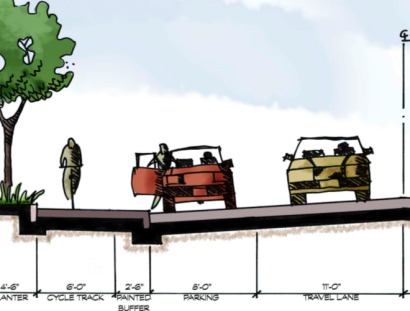
Nearly two years ago, we wondered whether it was time to try physically separated bike lanes. Now, the City of Portland is poised to build its first-ever, Copenhagen-style traffic lane for bicycles — otherwise known as a cycle track.
The cycle track is part of the Cully Boulevard Improvement Project, a multi-agency, $5.4 million project that will completely rebuild NE Cully Blvd. from NE Prescott to NE Killingsworth Streets.
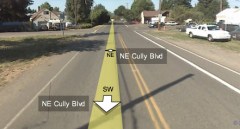
unimproved road with no sidewalks
or safety features.
Working from a clean slate, PDOT has recognized that this major road project is a rare opportunity to create a world-class bicycle facility from the ground up.
This morning I learned more about the project from Rob Burchfield, PDOT’s head traffic engineer.
He explained that there’s been a lot of interest in cycle tracks from within Portland’s planning and bike advocacy community, but that questions remained about how to implement them. The Cully project, he says, offers a unique opportunity because it’s, “a complete street reconstruction, something we rarely do.”
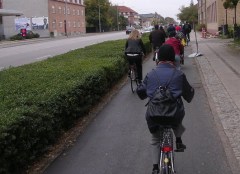
cycle track in Copenhagen last month.
(Photo: Jay Graves)
With a clean slate to work with, and a very wide right-of-way, Burchfield has seized on this opportunity to build, what he calls, “a bike facility to a European standard.”
Burchfield said he and his team initially looked at bike lanes on Vassar Street on the campus of MIT in Cambridge, Massachusetts. Those facilities put bike traffic on a wide sidewalk and use texture and colors to try and separate bikes and pedestrians.
The Vassar example has been criticized for not doing enough to separate bike and pedestrian traffic and Burchfield said a citizen committee working on the Cully project also had reservations about mixing the two modes.
It was at this point in the project when Burchfield urged everyone to abandon the Vassar design and embrace a Copenhagen-style cycle track. On Copenhagen cycle tracks, bikes and pedestrians have both vertical (trees or other median) and horizontal separation (at a different height from other traffic).
The current design for Cully has the motor vehicle roadway, then a 3-inch curb up to the cycle-track, then another 3-inch curb up to a planter median and pedestrian sidewalk.
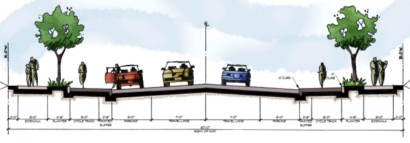
When Burchfield first pushed for the Copenhagen-style design, he hadn’t yet visited the city. That changed in October when he was part of a delegation that visited Amsterdam and Copenhagen to learn and see first hand how the best bike city in the world designs its roadways.
That trip, according to Burchfield, “strongly validated the direction we were going.”
So, how does it work? What will people on bikes experience on this new cycle track?
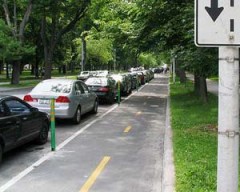
Burchfield says the cycle track would be constructed from concrete, smoother than a sidewalk, and longer lasting than an asphalt roadway. Bike traffic will also enjoy a comfortable width. Current design calls for a cycle track that’s 8 1/2 feet wide (including a 2 1/2 foot buffer for opening car doors). For comparison, the standard city bike lane is 4-5 feet wide.
At intersections, the cycle track will drop back to the street in order to cross, and then will start up again on the other side (Burchfield mentioned that on high volume cycle-tracks in Copenhagen, bikes have their own signal at intersections).
Burchfield said they’re still thinking about how bike traffic will leave the cycle track to make a left turn or access a driveway or business on the other side of the street mid-block. He said they’ll design the curbs to be “rollable” so that bike riders can easily leave the cycle track.
Another aspect of this new design is having parked cars between two lanes of traffic. “The parking will give more buffer to the cyclists,” says Burchfiled, “but also makes you less visible.” It’s important to note that on Cully, since it’s a largely residential street, there isn’t expected to be much demand for the on-street parking spaces.
According to Burchfield, a new Cully Blvd. cycle track is likely to cost less than a standard bike lane facility. Because the cycle track is on a separated grade and will be made from concrete, the city has less width of (increasingly expensive) asphalt roadway to build. Burchfield pointed out other advantages as well; “We’ll have less street to maintain and in terms of life cycle, a concrete surface built well, will be much better in the long term than asphalt.”
“You need to take that first step somewhere and this is a great opportunity to do it.”
— Rob Burchfield
While they provide more space and comfort for bike traffic, cycle tracks are likely to draw the ire of vehicular cycling proponents who tend to oppose separate facilities. From sources close to this project, we’ve learned that some of the same critics of Portland’s bike boxes have already raised questions about PDOT’s move toward cycle tracks.
When I brought that up to Mr. Burchfield, he was aware of potential controversy, but said this project has one major difference from the bike boxes. Cycle tracks, he said, are more of a street design and “built environment” issue and don’t involve traffic control elements like the bike boxes did (meaning that, some of the controversy was around the fact that bike boxes were new traffic control devices that hadn’t been properly vetted before installation).
For Burchfield and the rest of PDOT, this is an exciting project and it represents an opportunity for Portland to live up to its green and bike-friendly reputation.
“You need to take that first step somewhere and this is a great opportunity to do it,” says Burchfield, “I don’t see any downside in this case.”
The Cully Boulevard Project isn’t slated for completion until 2010 and the final design will be put to a City Council vote before it’s built. As for the innovative cycle track component making it through to final construction, Burchfield is optimistic; “From a design feasibility standpoint, we’re comfortable with it. We’ve really got the design worked out.”
[Editor’s note: The City of Portland, working with Portland Streetcar, is also planning to build a separated bike lane (similar to this one in New York City) on NE 7th Avenue through the Lloyd District as part of the streetcar plan. I’ll have more on that next week.]



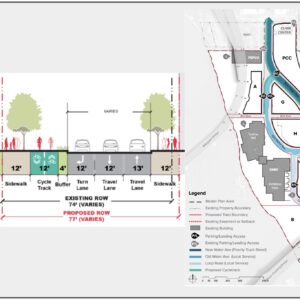
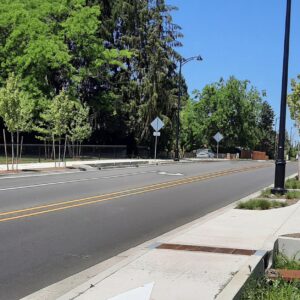

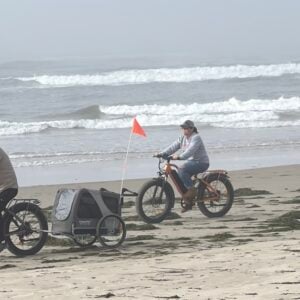
Thanks for reading.
BikePortland has served this community with independent community journalism since 2005. We rely on subscriptions from readers like you to survive. Your financial support is vital in keeping this valuable resource alive and well.
Please subscribe today to strengthen and expand our work.
The intersection crossing has me worried. As stated there are bike only signal in the EU.
At crossings that only have a stop sign on the cross st, while Cully has the right of way what will be the situation with the bike track?
The vehicles on the cross st will obviously have to stop before the bike track but there will be a need for cars to pull forward over the bike track to determine if it is safe to turn onto or cross Culley. Line of sight and all that. Does the bike track have right of way over the cross street or do they have and enforced stop at every intersection? Does a car have the legal right to block the bike track while trying to gain access to Cully due to excessive traffic on Cully?
Jonathan: Regarding this quote:
the city has less width of (increasingly expensive) asphalt roadway to build.
With oil prices have dropped below $50/barrel recently, shouldn’t the price of asphalt also be dropping quickly as well? It’s my understanding that the price of asphalt is pretty well tied to the price of oil.
Wow — that’s really interesting. I look forward to seeing how this develops.
I think in general, this is really exciting for me – in cycling around town, I find that areas where bike traffic is completely removed from car traffic (such as going over the Hawthorne bridge) have a totally different, relaxed, safe feel to them, even in comparison with “bike boulevards” such as SE Clinton ST. I think this exists for both types of traffic, as going down narrow streets such as Clinton, auto traffic often has to wait for bicycles as well, which makes drivers frustrated and cyclists feel hurried and pressured (from personal experience on both sides of the coin). I think having completely separated traffic as much as possible is the ideal best situation for safety and comfort for both motorists and cyclists.
I like it.. Infrastructure changes like this, built environments, are slow…but bring it on….create the standard…let everyone see it and get used to it…
and then build more…and more…and more….
tax my next bike 5$…I don’t care.
please just let them make the pedestrian path out of something that the joggers won’t complain about.
the last thing i want to see is people walking/jogging on a “cycle track” when there is a perfectly good sidewalk right next to it.
i’m almost entirely convinced that no one in portland uses sidewalks anymore. well, at least when it comes to joggers/speed-walkers….and your occasional person in an electric wheel chair going the opposite direction in a bike lane while dragging a trash can behind them. (the crazy thing is i’ve seen it happen on more than one occasion and in various places around town…just not always with a trash can and sometimes just in the middle of the road).
>>>> r’s comment about joggers etc. in the cycle track…>>>>
I wonder if the cycle track will have a designation different from a sidewalk or a MUT and if there’s even a bike-specific designation under Oregon or Portland law. If it IS a MUT I’d think that joggers etc. would have equal claim to using the cycle track. With minimal bike traffic in that corridor it might not be a big deal, but with the levels of bike traffic we have in some places coexistence could be dicey with joggers/walkers.
Cyclist (comment 2):
With oil prices have dropped below $50/barrel recently, shouldn’t the price of asphalt also be dropping quickly as well? It’s my understanding that the price of asphalt is pretty well tied to the price of oil.
Actually, there’s a nationwide asphalt shortage. Something to do with retrofitting refineries to process oil more cheaply, but it means the crude stuff and another chemical that go into asphalt aren’t being made as much any more.
Re cyclist @#2:
The price of asphalt has been and is expected to continue to rise separate from the overall price of oil. The reason for this is that increased efficiencies in the distillation processes to produce gasoline and other fuels had led to less ‘waste’ materials that are subsequently used for asphalt being available.
For more info see about halfway down in this article: https://www.npr.org/templates/story/story.php?storyId=96798844
Cyclist #2, prices are tied to to both supply and demand. While the price of motor fuels and asphalt are tied to the price of oil on the supply side, the demands for motor fuels and asphalt are independent on the demand side. Right now you have dropping demand for motor fuel (plus other oil based products), but a high demand for asphalt.
When you factor in the value of the products derived from oil, you find that the high value products (motor fuels) have an exaggerated influence on the demand and supply. So it is entirely possible to have a a reduced demand for oil and falling prices for both oil and motor fuels, but still have an asphalt shortage that keeps asphalt prices high.
I guess what we need is bio-asphalt.
Cyclist #2, LOL, I guess I took too long to explain it. I was not trying to pile on, Elly and gus already had it covered.
Finally!
Now please include all the legal and physical aspects that make this sort of infrastructure work.
At intersections, the cycle track will drop back to the street in order to cross, and then will start up again on the other side
I’m not a road designer (yet), but this sounds wrong. it should be the cars that have to rise and fall – that, just because that’s the priority we should be giving walkers and bikers.
but there’s a practical matter, too – that is, safety. if possible, walkers and bikers should always stay as high (yes, as in altitude) as possible on the street to stay visible – no more little kids disappearing under the grills of pickups.
i _think_ this is a good way to do it, with the lane markings, visual demarking, etc:
http://hembrow.blogspot.com/2008/11/maintaining-priority-in-countryside.html
it may be more expensive to do it this correctly, but if we’re going to do it right, let’s do it right.
and it may slow down cars, and that’s a good thing, too.
unless PDOT includes a bicycle phase in the signalization, like Copenhagen does, the design really isn’t complete.
Way to see PDOT’s head traffic engineer take the lead on making a physically separated bike path!
I’m really happy that they will get started on it, and fully expect it will leave the same void feeling that a single Sunday Parkway left – when will there be more!? Do we really have to wait until 2010 to see it happen?
r…#6….I have to agree..
joggers have been told repeatedly by training magazines and “experts” that asphalt is “softer” than cement (typicaly sidewalk material) so they take to running in bike lanes into oncomming bikes…which, by law, is against the law…
I quit moving for them some time ago as I find it a fairly rude and inconsiderate thing to do when it forces me out into the street…it fun to watch them just out of the way occasionally…but typically they get the point when I get close enough…
In both OR & WA, it is illegal to walk in any roadway when there is a sidewalk furnished on at least one side of the road. I think that that IQs have dropped drastically (to quote Lt. Ripley) in the past ten-fifteen years, judging by the number or people who walk up the street instead of the sidewalk, and then look askance at cyclists or autos trying to get by in the road. (I’m all for ditching cars but not by challenging them head-on with my carcass…)
Despite what planners may think, I don’t believe there is such a thing as a “bike path” in the USA. They’re all MUPs or SUPs (multi-use or shared-use paths).
Down in Santa Monica, there is a twenty-mile stretch of “bikeway” that runs along the beach, called The Strand by the locals; there used to be stenciling at the beginning and major connectors, right across the path, reading: BIKES ONLY. Uh-huh. On any reasonably nice day (this is the beach in California), you can basically stand anywhere and see hundreds of users – rollerblading, jogging, stroller-pushing, moseying, dog-walking, and schmoozing @ .1 MPH on foot, with a scattering of racer boys and girls grimacing behind stylish sunglasses as they buzz by without warning between unsuspecting ungulates. I’ve seen similar (though smaller) melees on the Esplanade and the Springwater.
I am comfortable with vehicular cycling and riding in the street, but I always appreciate off-street routes too, and thus applaud this development. Good luck with that pedestrian separation thing (I’m liking the hedge in the 3rd illustration in the article above).
P.S. I should add its against the law when there is a sidewalk readily available…
Anecdote: there is an older Asian woman who walks rigth down the middle of SE Lincoln/Harrison almost every single morning with little regard for the dozens, if not hundreds, of riders coming right at her…its beyond strange.
My friend (and fellow cyclist) Mark is a city engineer in Beaverton and has been working with “pervious”, or porous concrete (see web article). Don’t know how the costs compare with asphalt, which I assume is engineered to support the heavier weight of automobiles, but maybe this is a friendlier alternative for a cycle path?
cyclist #2: The other thing, by the time this is built, and 10-15 years have gone by, and the street needs to be repaved, and the cycle track doesn’t, oil will be expensive again.
First off, separated cycle tracks are fully against the idea of sharing the road…
Second of all, this is merely between Prescott and Killingsworth. Minimal and very short.
It also, as described above, will dump cyclists out into one of the most difficult to navigate intersections in town, Killingsworth and Cully.
This intersection is the site of mass confusion, standard practices of stop sign running, California stops, etc.
You probably will wish you were smoking “Cycle Crack” when coming to the Killingsworth end of this “Cycle track”.
Once again, this is Portland people, not Copenhagen.
Let’s keep it that way, on keep bikes on the road where they belong.
Separation at this point will only help to fuel the arguments of those who hate having bikes on the road…
It’ll be hard to get a feel for it in only a half mile or so, but might as well try it.
A quick note on runners and roads. Runners have the same problem that cyclists do on sidewalks. They are often narrow and others (drivers, cyclists, etc.) are usually more focused on the road than the sidewalk. I’ve “tapped” a hood or two when motorists were looking past me down the street while trying to turn.
Newer subdivisions also place the sidewalk right up against the street and so you are constantly dealing with dips for driveways. Finally according to the Oregon Drivers Manual pedestrians should:
• Walk on the sidewalk next to the road.
• If no sidewalk, walk or jog on the left shoulder facing oncoming traffic.
As for the cycle track itself, I’m concerned that it runs the same risks that you have with riding on sidewalks with regard to being visible to people coming up on sidestreets, etc.
I do like the idea of creating some sort of buffer, such as a slight curb, that will keep motorists from intruding in the lane.
Thanks, Jonathan.
Two questions:
Once upon a time, the Cully rebuild included swales for sustainable stormwater treatment. Does the project still include those swales? Maximizing sustainability efforts should be mandatory in new street treatments. I’d be embarrassed for Portland if swales were sacrificed for this. It shouldn’t be an either/or.
The trivial, but fun, question: is Copenhagen really more bike friendly than, say… Amsterdam? Does mode split support your claim? I’d like to see the League of American Bicyclists rate the relative bicycle-friendliness of these cities.
Finally, a comment: one thing I’d think everybody could agree on is the merit of #13’s point: Design the intersections to send the signal that the safe crossing of bikes and peds is a higher priority than status quo treatment biased for cars. That’s pretty basic.
Hmm…intersting idea but why not extended it all the way to Fremont?
What is the ride share for bikes now on Cully Blvd.? Please do a study before construction begins. It will help justify claims that the side path increased ridership on that street.
#22 Killingsworth and Cully is a standard 4 way intersection with a traffic light. I pass through it nearly every day and it has a high level of compliance as far as I can tell. I think you must be thinking of a different intersection.
The greatest part of this facility is that it will connect tons of new high density housing near Cully and Killingsworth with the rest of town, and the rest of town with the new park that will hopefully be replacing the former colwood golf course assuming the appeal fails. Hopefully the city will extend the cycle track all the way to the park.
Interestingly one of the chief arguments the golf course was using against the proposed park was that the current bike/ped access was so poor that no one would come to the new park. This would certainly shoot a hole in that.
This new setup seems to add a ton of parking to Cully. There is really not a need for so much parking on this arterial street, why not build a narrower street with parking on only one side, or no parking at all?
All these years and they couldn’ even build a sidewalk where the poorest famillies in portland walk with their entire familly either in the street or in the dirt on the side of the road. Look at all the miles of unpaved roads in portland, some are not even navigatable by car, they also don’t maintain the streets that are paved.
rant, rant rant….
I have a lot of questions about how this will work, particularly relating to conflicting right-of-ways, so I’m glad to see it “in real life.” I’m doubtful the first attempt will be everything we hope, but it’ll be a great starting point from which to learn and improve.
Jim (#28) – declining fuel tax revenue has a lot to do with why roads aren’t maintained well.
To the best of my somewhat limited knowledge, any unpaved roads (like where, by the way?) within the city limits are not official streets, as bona fide streets must be paved and maintained to some minimal standard. So those are little more than access easements, and the government has no right, much less any obligation, to build and maintain those pathways. To become streets, the owner of the easement usually must bring them up to standard on their own dime, then petition the city to take over maintenance.
It sounds wonderfull.
Why I think I am tearing up;)
Nice idea for the cycling Mormon missionaries. I probably wouldn’t use it. The intersections will be a BIATCH. Way too MUCH engineering.
For the rest of the REAL world:How to Roll a Busy Two-Laner, WITHOUT Really Trying
Oregon State law says
814.070 Improper position upon or improperly proceeding along highway;
penalty.
(1) A pedestrian commits the offense of pedestrian with improper position upon or improperly proceeding along a highway if the pedestrian does any of the following:
(a) Takes a position upon or proceeds along and upon the roadway where there is an adjacent usable sidewalk or shoulder.
Basically if the sidewalk exists the runner has to use it!!!
I have recently moved from PDX to Denmark and have a great appreciation for the Danish cycle path system. It’s a very common system throughtout the EU where bicycles have the right of way. It’s very common for all vehicles to pause and let a cyclist through an intersection. Simply Awesome! Of course cyclists must still pay attention and also comply with rules such as front and rear lights.
I foresee some difficulties with a small zone of PDX adopting this system, but I feel PDX should still pursue the cycle path concept. In the long run it’s the way to go and if any US city can pull it off it would be PDX.
Hoewever, it might be very frustrating for riders that are cut off or potentially right hooked. The one advantage of bikes on the road way is that they are more visible to motorists. If riders are on a pathway that vehicles are unfamiliar with cyclisits might be at risk in this “cycle path zone”. Yes, the pathway is elevated a bit but only a few inches plus some minor contour. Afterall no cyclist wants some monster curb to navigate if congestion occurs with another cyclist or a wandering pedestrian. I guess one concern is….Where does the cycle path education for motorists occur?
Maybe creation of cycle paths will make motorists consider an alternative route? Wouldn’t that be fantastic!!
I’m all for it….cycle paths need to start somewhere but then grow enough to make a great city-wide system. Bottom line…Is funding really there for such a system??
They’re ” still thinking about how bike traffic will leave the cycle track to make a left turn or access a driveway or business on the other side of the street mid-block.”
Isn’t this one of the huge inherent fatal (in several senses of the word) flaws of separate paths? Out here in the midwest, I’d thought Portland was a leader in things bicycling, but this looks like a step backwards. From our LIB website: http://www.bikelib.org/muniguide/index.htm – Where there are many crossings, the intersections make sidewalk or sidepath riding more dangerous than riding on the road!! Lack of expectation and visibility, plus questions about right-of-way, lead to these higher accident rates. And, it’s much worse for cyclists riding against the flow of adjacent traffic.
I’m confounded as to how these are different from MUPs.
The only way to make a separate path truly safe at intersections would be to give path users right of way over road users, and put some major teeth in violating path users’ right of way. I’m talking major fines, or suspensions of licenses, or even requiring passing a retest, written and practical before allowing the driver to have his/her car back…
I think I meant the bad intersection is Prescott and Cully.
My bad.
I can’t wait to see this in action. I live in Seattle but I used to live in Portland. I think I will make time to ride this when I am down in Portland after the STP, assuming it is built then.
So the opponents don’t want us on the street, impeding their cars. And they don’t want us off the street, on our own separate pats, either. Essentially they just don’t want us around– awesome. It’s time the public stopped listening to the stick-in-the-mud whiners who shake their fist and act all hurt over what any reasonable, rational person would regard as progress.
“Where there are many crossings, the intersections make sidewalk or sidepath riding more dangerous than riding on the road!! Lack of expectation and visibility, plus questions about right-of-way, lead to…higher accident rates.”
These are my thoughts exactly. Besides being trapped on one side of the road, unable to make left turns except by the “pedestrian” method, crossings are made more dangerous by having cyclists out of sight until their path crosses with a car.
Separated cycling paths are great for long-distance “expressways” where there are no destinations along the path, e.g., Springwater Trail, US 26 bike path. Through neighborhoods and business districts, on-street riding, perhaps with a bike lane, is the safest option.
Burr in #14 is right: because what these separated lanes do is, in effect, create a little bike street running parallel to the car street, a bike light will be necessary and drivers will need to be made aware of cyclists’ right of way.
And Michael in #35 has it right: “The one advantage of bikes on the road way is that they are more visible to motorists.” We all know the importance of visibility. But the more separated you are, the less visible you are.
A separated bike lane like this is a fine idea for the suburbs, where the priority is on covering long distances quickly, but it would be wrong for downtown. Something more like a Shared Space (http://en.wikipedia.org/wiki/Shared_space) would be better for downtown.
This is a lesson taken directly from Amsterdam: pedestrians (tourists) downtown usually treat the separated cycle tracks as an extension of the sidewalk. The separation between the sidewalk and the bike lane, and the the bike lane and the roadway, is shifty. (I only hit one pedestrian during my week there.) The further you get from downtown, the more useful the separation becomes.
In Montreal, bike lanes are both separated and in the roadway: it’s like they claimed the right lane for cyclists by laying a long painted curb in the road. That could be a cheap and easy solution.
OK, I would be apt to back off my “dangerous crossing” concern iff there were a signalizing solution where there were two straight-ahead light cycles, one for autos (with no right on red) and one for bikes. Especially if the bike signals could be triggered by a sensor far enough away from an intersection that the bike light would be green by the time a rider arrived at the intersection…
I like it, but I’m curious what the plan is to keep the separated path clean and clear of leaves.
I biked in Copenhagen once and it was nirvana.
Most of the concerns about cycle tracks posited here were addressed in today’s presentation by the city’s traffic engineer, Rob Burchfield, former bike coordinator Mia Birk, and Bike Gallery owner Jay Graves. I’m guessing Jonathan will have a separate post on it, and much of the info will, they said, be posted at http://www.altaplanning.com/. The facts and history show that the separated cycle paths (with appropriate signaling etc.) are far safer than current American practices.
I’d just like to point out how terrible our sidewalks really are for a runner. Every 50 feet you run the risk of twisting an ankle due to all the tree roots pushing up parts of the sidewalk, making them uneven and dangerous. Rarely is this issue addressed. Also, there is a tendency to run across inexperienced cyclists and neighborhood children on sidewalks, who like bike ninjas, pop up out of nowhere.
I like the _idea_ of the cycle track. However, it does seem this would be way more effective in places where it could stretch farther than a half mile.
Quoting brettoo “The facts and history show that the separated cycle paths (with appropriate signaling etc.) are far safer than current American practices.”
Sources, please? Some entire countries where separated cycle paths are common have a lower crash rate. But every study I’ve seen comparing the same bicyclist population and geographic area, including the recent Copenhagen study, show that riding in the street is safer than on facilities of the type described for Cully (called “bike lanes” in the Copenhagen study, but they are behind parked vehicles). Do you have anything to refute this?
Also, a photo caption of a facility in Montreal, at the top of this thread, indicates that it is like what is proposed for Cully. No, comparing Montreal vs. Cully:
* Single sidepath with two-way bicycle traffic vs. two sidepaths, each with one-way bicycle traffic.
* No barrier vs. rollable curb.
It looks to me as though the Cully project is going to have safety issues with driveway crossings. There also are, as Mr. Burchfield notes, issues with how bicyclists are to make left turns — but also with the longer trip necessary to continue to the next intersection, make a U-turn and come back to reach a destination on the far side of the street, leading to unpredictable street-drossing maneuvers and riding against traffic. Oregon’s mandatory sidepath law would apparently make it illegal to ride on the roadway to prepare for a left turn into a driveway, etc.
I have seen some locations where sidepaths are the preferred alternative and/or are well-designed to reduce conflicts. I am not at all convinced that the proposed facility on Cully will be.
The criticism of the Vassar Street facility quoted in the posting is my own. Thanks for the link — but Vassar Street also differs in some important ways from the design for Cully — notably in that there is no effective separation between bicyclists and heavy pedestrian traffic.
How many Portland bicyclists have to die before Portland bicyclists realize that the single biggest factor which determines the safety of a given cyclist is not whether the riding is on a road or on a separated facility, not the behavior of motorists or anyone else, but the behavior of that bicyclist? How many? If only this money were spend on something that would actually make cycling safer, like fixing pot holes and eliminating dangerous grate designs with slots parallel to the road that swallow bike wheels.
In the mean time, it will be interesting to see how many will be injured and killed because of this cycle track. It’s so short it might be only one death every few years, but those seeking to kill bicyclists should not be glum. Surely they will build more of these death traps soon enough, and then the cyclist death rate will climb.
“So the opponents don’t want us on the street, impeding their cars. And they don’t want us off the street, on our own separate pats, either. Essentially they just don’t want us around– awesome. It’s time the public stopped listening to the stick-in-the-mud whiners who shake their fist and act all hurt over what any reasonable, rational person would regard as progress.”
Analyze your text and that of those who ask questions and see who’s whining, fist-shaking and name-calling.
It’s ‘way too easy to get truly unsafe facilities approved and built. My town’s got a stretch where the bike path intersects a busy bus stop, among scads of otehr serious hazards. The public is ‘way more likely to listen to the folks who just want us out of the way when there are “bike facilities” that don’t work so those cyclists who just want to survive don’t use them.
How many cyclists use Cully now? Studies need to be done or opponents of this type of facility will claim rider-ship has not been increased, and we will need the data to refute them.